Cable exercises offer an incredibly diverse range of benefits to every lifter. They are potent tools to optimize hypertrophy training, and offer a joint-stabilizing option between rigid machines and free weights. Cable exercises can give you more movement freedom than other machines, but also offer more guidance than free weights. This means that cables are great for getting a pump without too much joint stress.
Cable systems require a little bit of forethought to correctly set up — make sure you’re following the diagrams that are often on the machines closely. But once they are dialed in, they offer a consistent challenge to your muscles. This allows a much more accurate and efficient training stimulus than many other training implements in the gym.
This article will cover the best cable exercises to kickstart your training and will teach you how to train with cables for the most efficient, effective workout.
The 15 Best Cable Exercises
- Cable Crunch
- Seated Cable Row
- Cable Lateral Raise
- Cable Kickback
- Cable Curl
- Face Pull
- Lat Pulldown
- Cable Pull-Through
- Cable Pallof Press
- Cable Pressdown
- Straight Arm Pulldown
- Overhead Triceps Extension
- Cable Pec Flye
- Cable Reverse Flye
- Cable Shrug
1. Cable Crunch
The cable crunch breathes new life into an exercise that has a seemingly short runway of progression. The free weight iteration of the weighted crunch becomes increasingly more difficult to progress because of the inability to easily stabilize or standardize the placement of the load. Similarly, the machine variation often has limitations on the ability to accommodate different body shapes and sizes. Enter the cable crunch, which provides consistent resistance and a customizable set-up for a wide range of body types.
Benefits of the Cable Crunch
- Accommodates all body sizes.
- Consistent loading.
- Scalable resistance.
How To Do The Cable Crunch
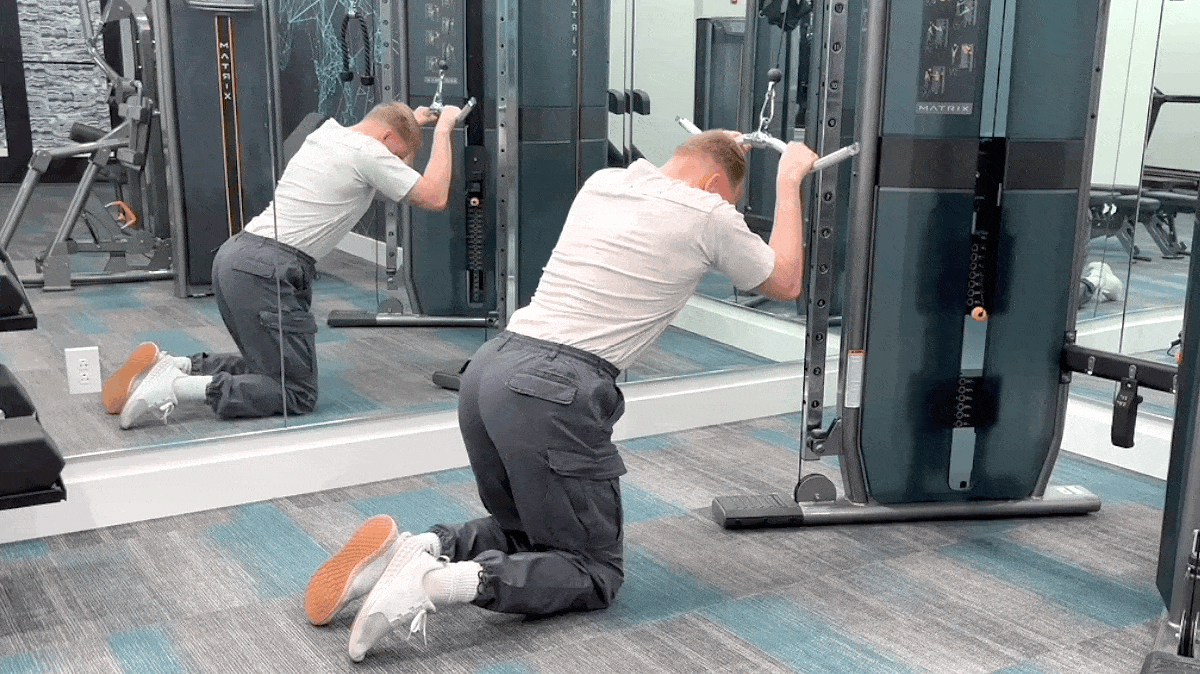
Place a mat on the ground under your knees to serve as a starting position. Position a heavy dumbbell, bench, or any other weighted object behind the mat to help anchor your legs. While facing the cable stack, grip a rope attachment. Then kneel down with your body positioned slightly back from the machine. The cable should be subtly pulling your body forward. Anchor your legs against the heavy resistance. Contract your glutes to stabilize your hips and contract your abdominals to curl your torso towards your legs. Control each repetition such that your hips aren’t shifting back and forth.
2. Seated Cable Row
The seated cable row allows for several variations of hand grips and elbow angles to target different back muscle groups. A major advantage of the seated version is that the legs can act as an anchor. This allows you to really drive towards muscular failure with increased stability and comfort. The legs acting as a brace also allows you to protract the shoulder blades, which can help build up the rhomboids.
Benefits of the Seated Cable Row
- Leg support for stability.
- Multiple different hand grips and orientations to target specific muscles of the back.
- Much safer to train to fatigue than free weight variations.
How To Do The Seated Cable Row
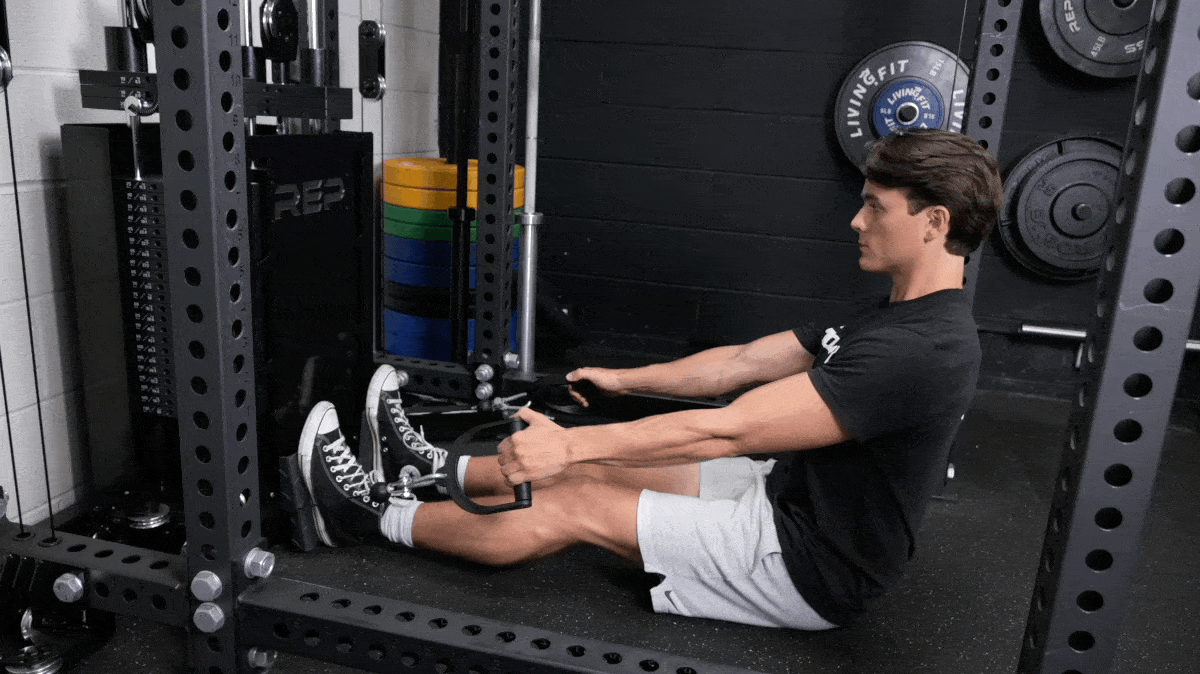
Sit down on the floor with your feet hip-to-shoulder-width apart on the foot pads. Assume a hinge from your hips. Use your posture and appropriate knee bend to provide a stable brace against being pulled forward. Using your back muscles, draw the handles towards the body. Control the cable’s return toward the stack and repeat.
3. Cable Lateral Raise
Cable lateral raises take advantage of the ability to customize the height of the handles on most cable stacks. By raising or lowering the starting position to accommodate your arm length and height, the cable lateral raise can quickly be woven into nearly every workout program.
The disadvantage of the dumbbell lateral raise is that the weight always feels the heaviest at the top, where the muscle is at its weakest. Using the adjustable starting position, the cable lateral raise can manipulate the most difficult part of the exercise. This means that you can stave off early plateaus by having a more consistent level of resistance throughout the move.
Benefits of the Cable Lateral Raise
- Adjustable to accommodate an individual’s limb length and height.
- Allows the lifter to experience peak challenge at different ranges of motion.
- Able to challenge the muscle with less absolute load.
How To Do The Cable Lateral Raise
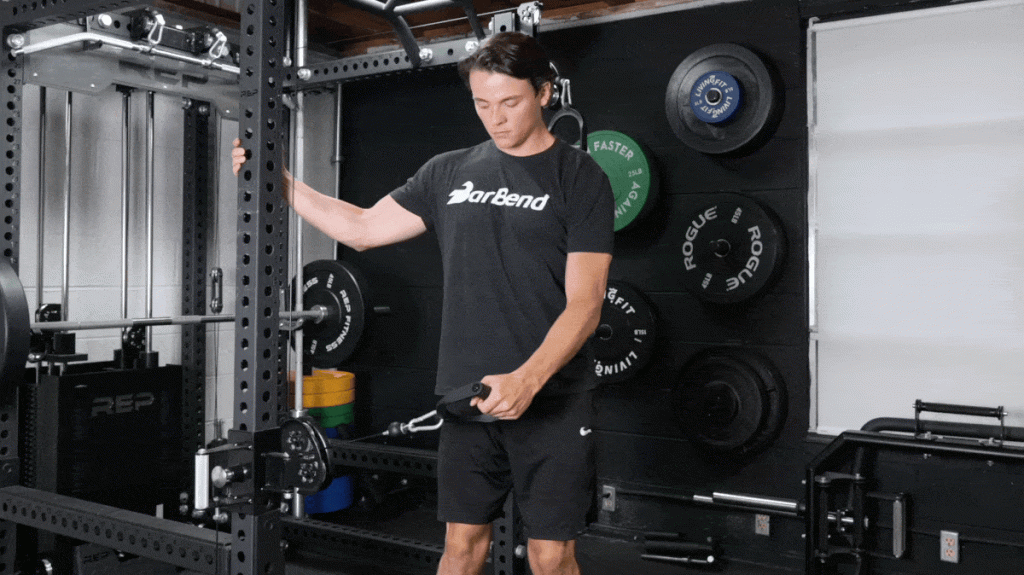
Stand beside the cable stack so that the hand gripping the handle is on the outside of the body. You want the grip height to allow your arms to fully extend. Take a small step away from the cable stack with your hand facing towards the machine. Allow your arm to drift slightly ahead of the body to best target the middle deltoid muscle. Raise your arm against the resistance until it reaches slightly above parallel to the floor. Lower with control and repeat.
4. Cable Kickback
The cable kickback is a glute exercise that lets you isolate your backside in a range of motion tailored for you, as opposed to the predefined path a machine version would force most people to perform. A properly-executed cable kickback also reinforces positional cues that will best stimulate the glutes. This exercise is open-chain, meaning that the working leg is not fixed on the ground. In this way, the cable glute kickback helps target the gluteus medius and maximus in each contraction.
Benefits of the Cable Kickback
- Integrates core bracing principles to properly execute.
- Allows stimulation of the glutes with less absolute load.
- One of the few open chain glute exercises.
How To Do The Cable Kickback
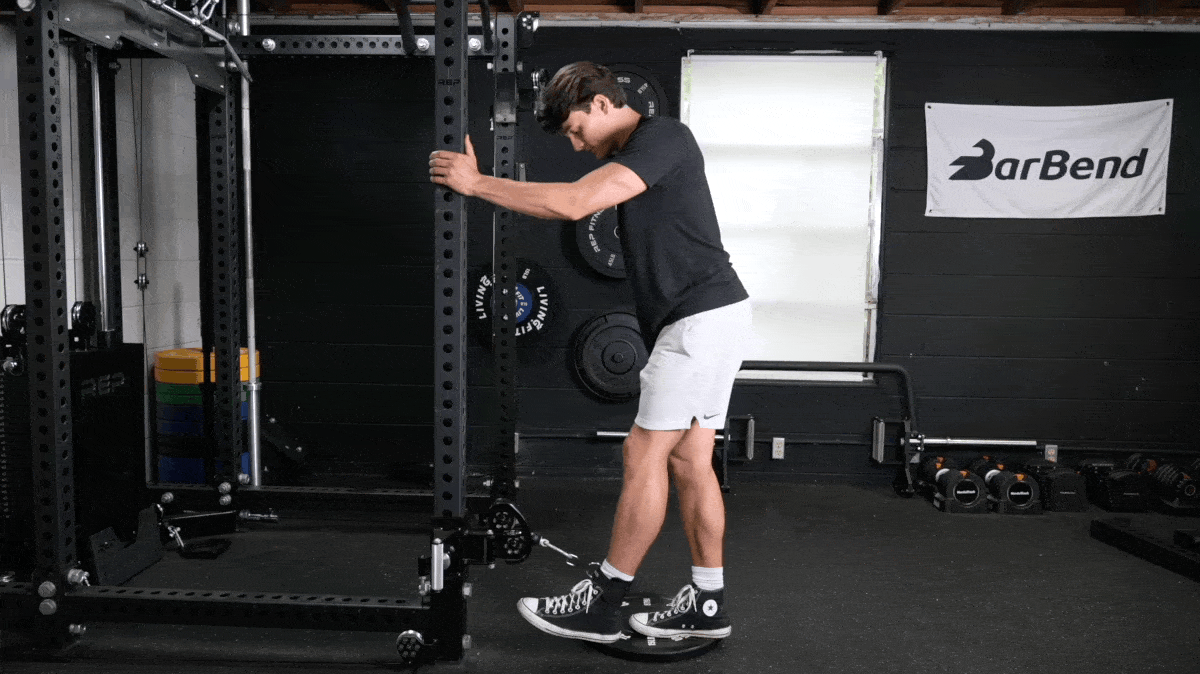
Attach an ankle strap to the cable stack positioned at the bottom of the machine. Face the machine with the ankle cuff attached to one leg. Step far enough away to allow your body to hinge towards the cable stack. Pin your ribcage down and stacked over your pelvis. Brace your core and contract your glute to extend your loaded leg backwards against the resistance. Kick back until just before a loss of torso position would occur (a flaring of the ribcage). Then return to the starting position and begin the next repetition.
5. Cable Curl
The cable biceps curl is another exercise that benefits from using cables unilaterally. While a straight bar, EZ bar, or other grips are useful, the cable curl is most effective when each arm is allowed to work independently.
The biceps are a long muscle with fibers that run more or less straight up and down the length of the upper arm. In order to best directly stimulate them, you want to line up the resistance to movement directly opposite that straight line. But with free weights or fixed machines, that can be hard. The cable system allows a much freer set up, so your limbs can move at their best.
Benefits of the Cable Curl
- Consistent load.
- Peak challenge can be manipulated to target the beginning, middle, or end range of motion.
- Allows a customized set up to best align the arm.
How To Do The Cable Curl
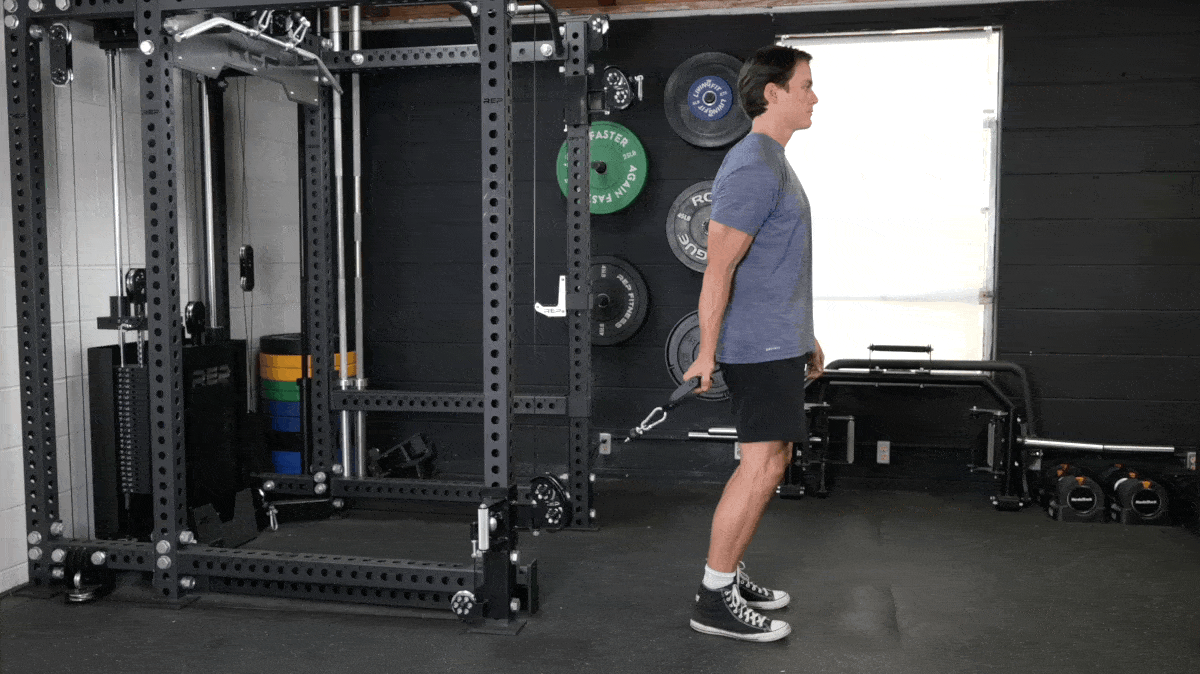
Assume an underhand grip on a single cable handle. Take a modest step forward while facing away from the cable stack. While bracing against a fixed reference point, contract the biceps to curl the arm. Maintain a consistent elbow position the whole time to best target the biceps.
6. Face Pull
The cable face pull is a staple in the warm-up routine of many upper body workouts. High repetition sets targeting the rotator cuff and traps can pump up the upper back. While the face pull can be accomplished using a band, the constant tension provided by the cable stack is very helpful. Cables will target small muscle groups that can be potentially overwhelmed by elastic tension from bands.
Benefits of the Face Pull
- Targets the upper back and rotator cuff muscles.
- Easy to execute.
- Scales better than band versions.
How To Do The Face Pull
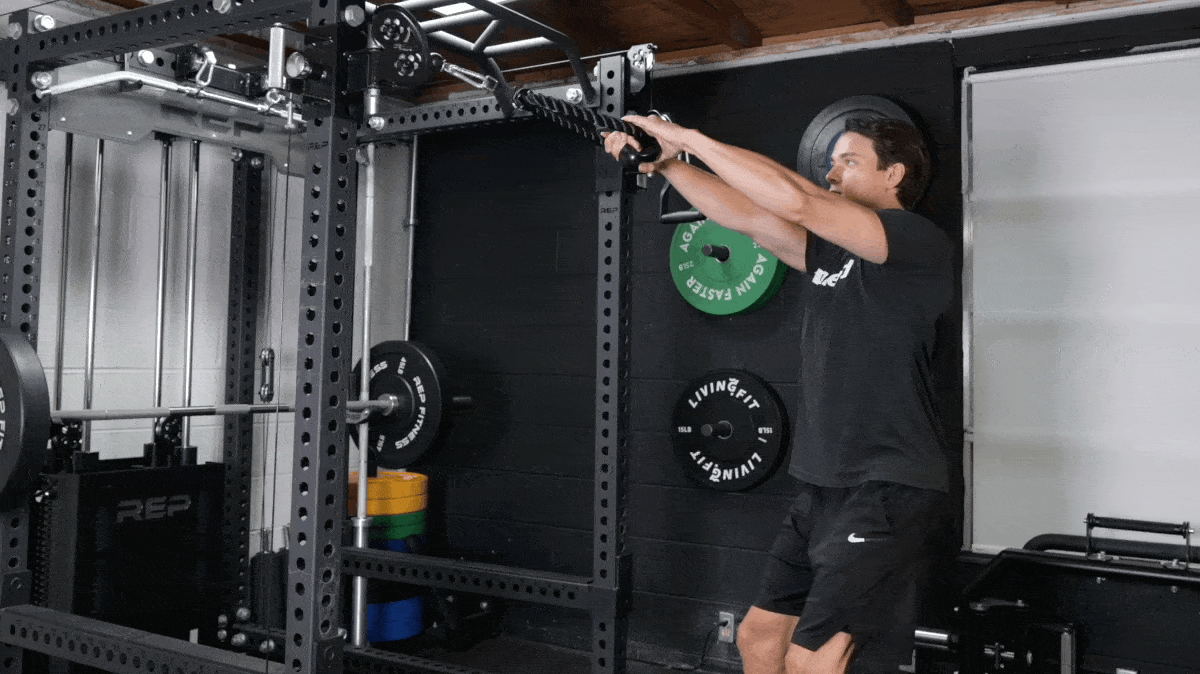
Select a cable stack height where the long D-handles or rope attachment roughly matches your eye level. Take a large step away from the machine. You want the weight load against your body when your arms are fully extended. Subtly lean back against the resistance. Use your upper back muscles to pull your hands towards the face. Pull the rope apart as the implement approaches your body.
7. Lat Pulldown
The lat pulldown is a classic gym staple for a reason. You can use multiple grip positions and widths to target specific muscle groups with the lat pulldown. You also have the option to use either a bilateral or unilateral implement for even greater challenge.
Benefits of the Lat Pulldown
- Multiple grip and grip width options.
- Anchors lifter in place for easier bracing.
- Provides an overhead exercise to reinforce shoulder function.
How To Do The Lat Pulldown
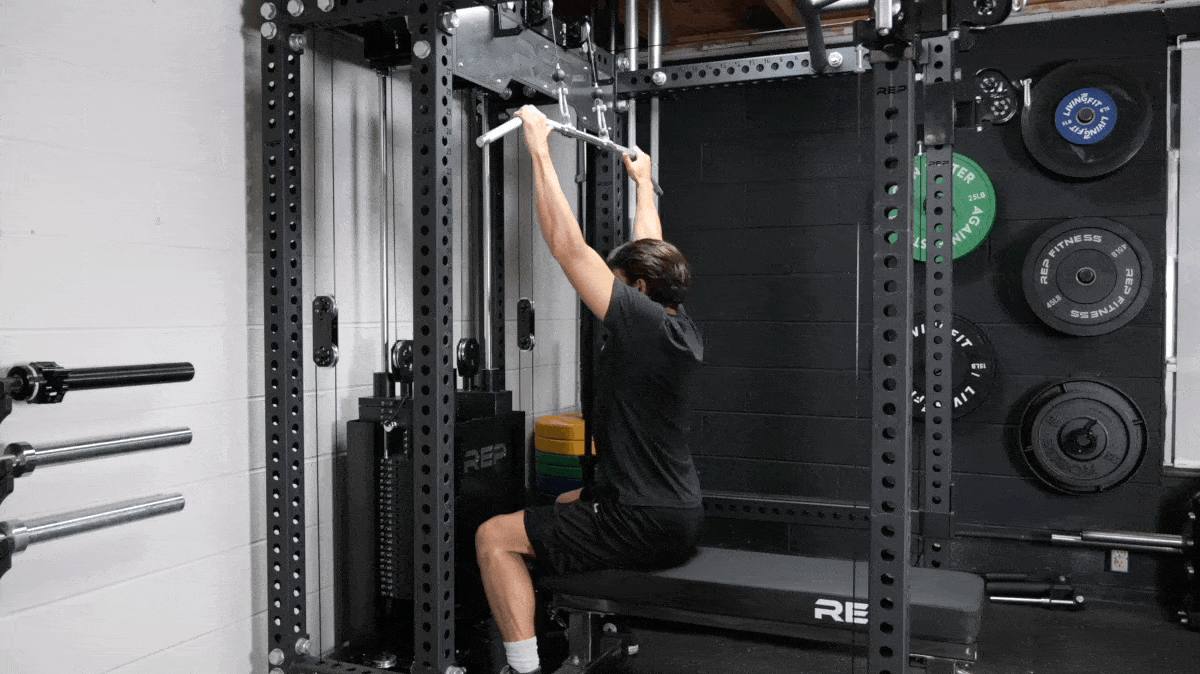
Pre-select the appropriate grip type and width for your lat pulldown. While holding the hand grips, sit down with the legs anchored under the pad. Pull your rib cage down and brace your core. Hold that alignment for the duration of the exercise while slightly tilting backwards. Pull the grip toward your body to complete each repetition.
8. Cable Pull-Through
The cable pull-through offers a low-impact variation of a hinge. This can help reinforce mechanics for exercises such as kettlebell swings without the direct loading through the spine. The cable pull-through makes for a great tool to begin teaching hinge techniques, warm-up, or as an adjunct to a hard lower body day.
Benefits of the Cable Pull-Through
- Targets the glutes with low degrees of spinal loading.
- Similar mechanics as a hinge.
- Able to be trained with high volume.
How To Do The Cable Pull-Through
Attach the rope handles to a low cable pulley position. Face away from the stack and grip the rope handles while standing over of the cable. Stand up while holding the grip — the cable should be between your legs. Take a modest step forward. Then brace the core and initiate a hip hinge by sliding the hips backwards towards the machine. Stand back up by contracting the glutes and hamstrings.
9. Cable Pallof Press
The cable Pallof press trains the core brace technique by using a rotational force that the lifter must neutralize. The cable Pallof press is a loadable version of the bird dog or dead-bug exercises. It can train or teach the concepts of anti-rotation for proper core engagement.
Benefits of the Cable Pallof Press
- Easily loadable core exercise.
- Teaches and trains anti-rotation.
- Scalable to all heights and limb lengths.
How To Do The Cable Pallof Press
Using a D-handle, adjust the cable stack height to be roughly that of armpit level. Take the grip and side-step away from the cable stack so that you’re facing sideways relative to the machine. While holding the grip close to your body, brace your core and tense your upper body to resist the rotational force. With control, press your arms away from your body. Hold tension in the fully extended position for a brief second before drawing it back towards you.
10. Cable Pressdown
The cable pressdown is a triceps isolation exercise that acts as a fantastic hypertrophy and strengthening tool for the arms. As a muscle building exercise, the cable pressdown or triceps pushdown is easily loadable. This allows for the rest of your body to serve as a brace to most effectively blast the arms. Depending on your body size and preference, either a straight bar, EZ bar, or individual handles can be effective.
Benefits of the Cable Pressdown
- Strengthen the triceps in isolation.
- Can be easily loaded.
- Can be safely taken to muscular fatigue.
How To Do The Cable Pressdown
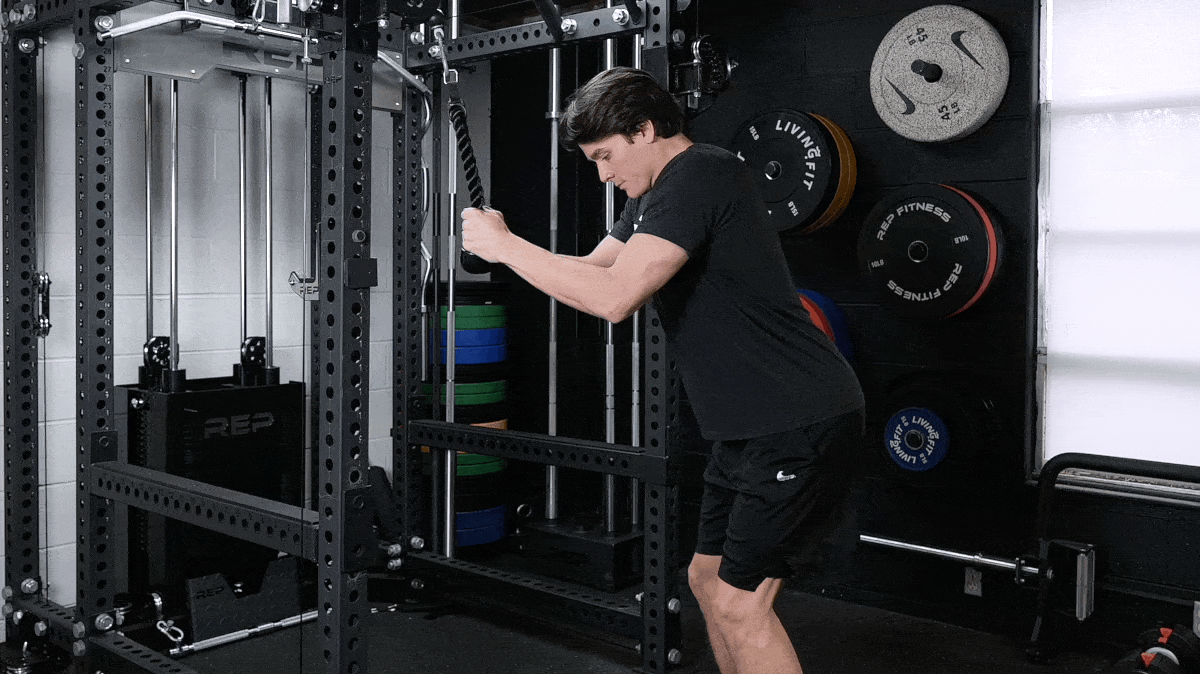
Start with the cable stack placed in the highest position and select the desired grip attachment. Using a double-overhand grip position, draw the cable down. You want your arms to run tightly alongside the body with your elbow bent as much as possible. Send your hips back in a hinge and brace your core. Press the grip attachment until your elbows are locked. Control the rope’s rise back to the starting position, then repeat.
11. Straight Arm Pulldown
The straight arm pulldown is an excellent mobility and warm-up tool for the lats – but can also be loaded progressively as a staple component of a full back day. The straight arm pulldown builds muscle with a sweeping motion. But because your arms are extended, you’ll need to use less weight than with bent-arm flyes. But you’ll still simultaneously mobilize and stabilize your shoulders while building your back.
Benefits of the Straight Arm Pulldown
- Excellent mobility and stability tool.
- Requires less loading to stimulate growth.
- Warm-up tool and mainstay muscle builder.
How To Do The Straight Arm Pulldown
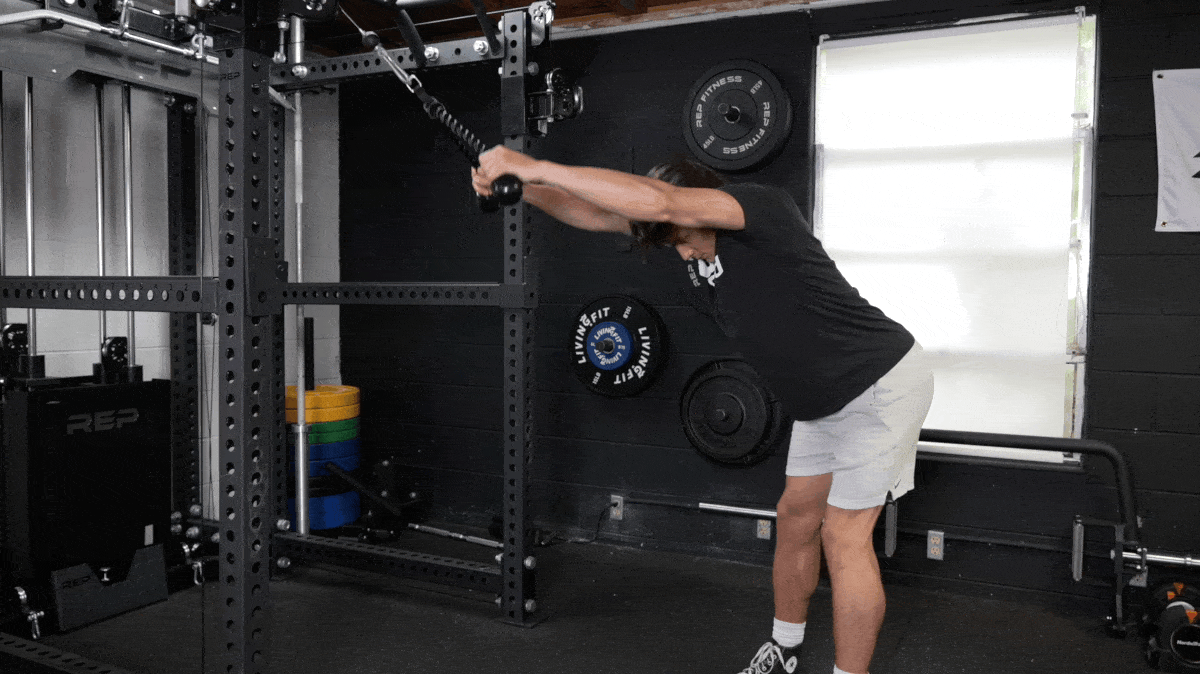
Using a straight bar or individual handle attachments, take a double overhand or neutral grip. With long arms, take a large step backwards. You want cable tension to remain on your body between each repetition. Maintain a slight bend in your elbow and assume a slight hip hinge to properly brace against the resistance. Sweep your arms down and towards your body in a long arc before returning to the starting position.
12. Overhead Triceps Extension
The overhead triceps extension is one of the most valuable exercises that can be performed with a cable. Overhead triceps exercises stimulate the triceps long head to optimally grow the muscle. Still, the challenge imposed upon the stability of the shoulder is often the limiting factor when using a free weight. Cable systems an overhead stimulus for the triceps while building shoulder stability.
Benefits of the Overhead Triceps Extension
- Safely challenges shoulder stability.
- Much more scalable than free weights.
- Targets the long head of triceps.
How To Do The Overhead Triceps Extension
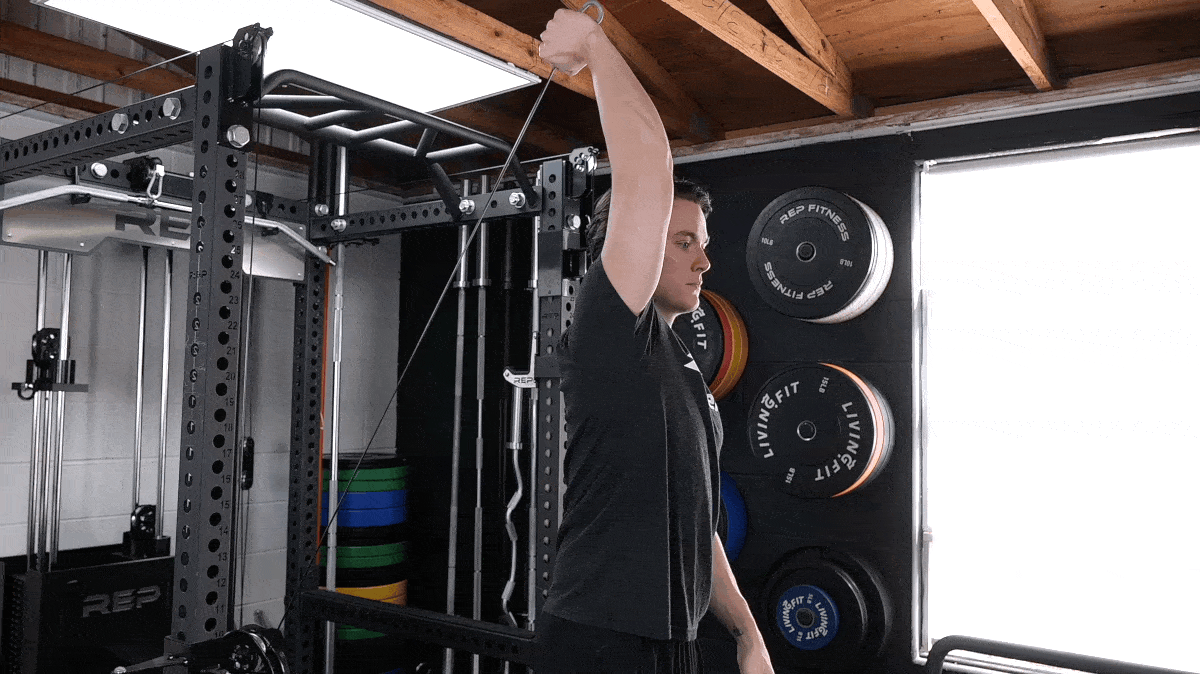
Using either a single-rope attachment or bare carabiner, grip the cable from the bottom position and face away from the machine. Raise your arm overhead and allow the elbow to drift forward slightly, angled slightly away from your ears. Bend your elbow as much as stability will allow with the hand lowering behind the head. Extend the elbow fully overhead to complete each repetition.
13. Cable Pec Flye
The cable pec flye allows the lifter to manipulate which part of the range of motion the greatest challenge to the pec occurs. Cables are also customizable, allowing you to target specific muscle regions of the pec to build (either upper, middle, or lower pec). This move requires greater degrees of stability and bracing. But it’s well worth it for the ability to individualize the exercise to your needs.
Benefits of the Cable Pec Flye
- Can target different regions of the pec.
- More stable than dumbbells.
How To Do The Cable Pec Flye
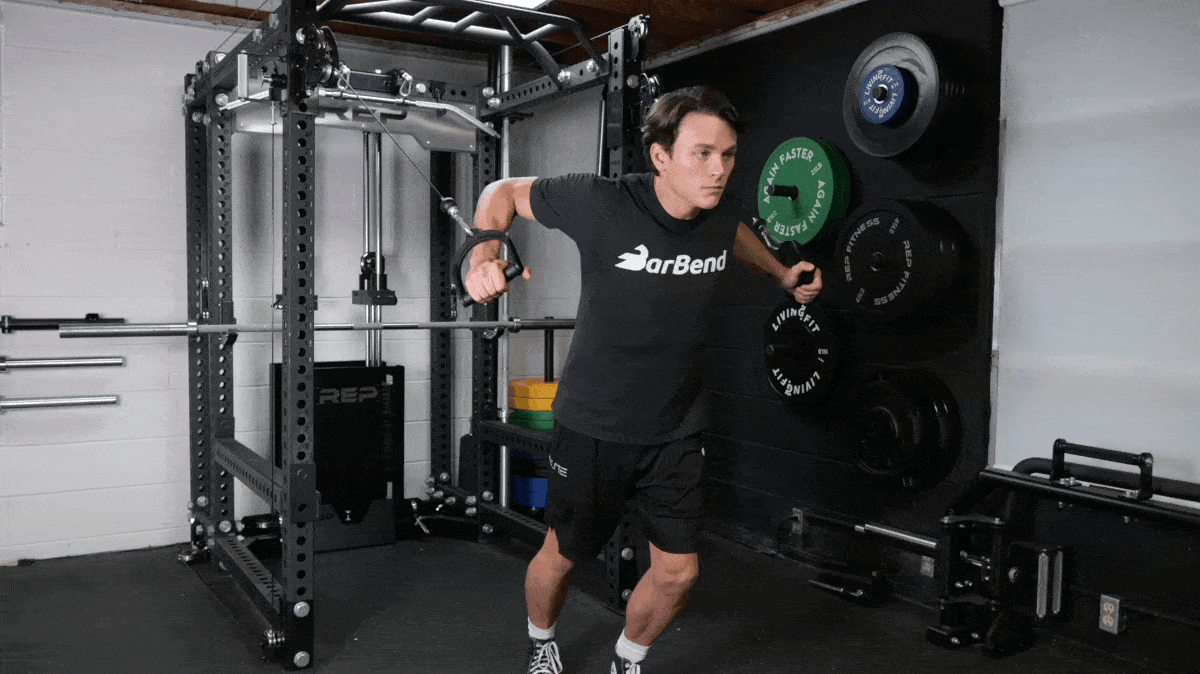
Attach the pulleys high up to target your lower chest; lower to target your upper chest; and around your chest height to target your mid-pecs. Grip the cables and assume a hinge position. Tilt to the degree that the line of pull from the cable will line up roughly with your armpit. Contract your pecs by drawing your hands towards each other in front of your body. With control, lower back to the starting position.
[RELATED: Best Lower Chest Exercises]
14. Cable Reverse Flye
The cable reverse flye is a massive improvement on the dumbbell variation of the same exercise. The dumbbell version can be effective at targeting the posterior delts. However, the classic dumbbell version puts the relatively small posterior deltoid in the most difficult position towards the lockout of the range of motion, where the muscle itself is weaker. Using a cable keeps the challenge consistent across the entire range of motion. This reduces the risk of injury or poor execution.
Benefits of the Cable Reverse Flye
- Consistent tension on the muscle.
- More stable than the dumbbell variation.
- Can more precisely approach muscle failure.
How To Do The Cable Reverse Flye
While either standing or seated, face the cable machine with a bare carabiner in each hand. Hold the carabiners in the opposite hands from the stack. In other words, your left hand should hold the right cable and vice versa. Subtly hinge to brace against the resistance of the machine. Then establish your starting position by extending your arms straight ahead of the body and your palms facing down. From here, draw your arms away from each other until they are flush with the rest of the body.
15. Cable Shrug
The shrug is another exercise variation that benefits greatly from utilizing a cable set up. The shrug is an exercise meant to target the trapezius, but many free weight variations struggle to properly stimulate the entirety of this large muscle. With cables, you can target the often under-stimulated areas of the traps.
Benefits of the Cable Shrug
- Compliments barbell or dumbbell shrugs.
- Can be precisely set up to accommodate all body sizes and limb lengths.
How To Do The Cable Shrug
Set up the cable height low. Stand so that each arm is aimed slightly diagonally towards your body. Grip one handle in each hand and take a step backwards. Your arms should be angled approximately shoulder width or slightly farther. Subtly hinge to brace against the resistance of each repetition. Contract your mid and upper traps to complete each repetition.
Benefits of Training with Cables
Cable exercises can be used to replicate machine versions that might not be accessible in every gym. They can also help you target a very specific area or muscle, which other exercises might not be able to. Not to mention, cable moves are often easier on your joints than free weights or fixed machines.
[Read More: The Best Ab Exercises & Workouts, According to a CPT]
A well set-up cable exercise allows for individualization of every exercise to accommodate your training goals and unique limb length. Cable systems are also invaluable for manipulating the exercise range of motion options or diversifying the degree of stability required. One of the best things about cable training is that it keeps resistance consistent throughout the exercise. This allows for a consistent challenge to the muscle, which adds valuable time under tension that helps with strength and growth.
Individuality
The fixed machines in many gyms simply cannot properly accommodate every body size. People of different physical sizes, shapes, or limb lengths might be constrained with typical machines. On the other hand, cables provide enormous exercise flexibility to best suit your individual needs.
Increased Movement Options
Cable systems let you target a wide range of muscle groups while also targeting specific areas of your body. While the body seems like it moves in straight lines, complete muscle contractions often involve varying degrees of rotation which cannot always be accommodated by a static machine.
[Read More: Best Upper Chest Exercises for Building Muscle]
Further, cables can help you target specific regions of large muscle groups like the pecs or lats. Cable machines can also help you target smaller muscles, like the rhomboids.
Consistent Tension
Changing degrees of difficulty throughout an exercise is an ongoing struggle for lifters. To truly develop a muscle to the fullest extent, bringing the muscle close to absolute fatigue is the goal. With many exercises, one particular range of motion becomes disproportionately difficult. Using cables creates variations of the same exercise to avoid this problem for as long as possible.
Stability
An unsung hero of cable exercise is the stability training aspect. Cable machines aren’t as demanding as free weights, but they offer a degree of stability training. In other words, you can individualize the movement more than a fixed-path machine could.
How To Train with Cables
Training with cables can be easily integrated into strength, power, or hypertrophy training due to the diversity of movement options and impact on stability. Cable training can be programmed as a stand-alone session designed primarily around building muscle. You can also use cables for complimentary accessory work based on the gaps left behind by barbells or other training implements.
Warm-up
It’s important to use a quick warm-up set or two in order to properly cue a cable exercise. Without warming up, you can have an inefficient set at best and potentially increase risk of injury at worst. Take a quick set or two in order to calibrate for the particular cable system of the day.
Hypertrophy Range
Cable exercises have increased stability requirements beyond that of fixed path machines. Therefore, it’s often best to assume hypertrophy training parameters to most effectively perform each exercise. Performing six to 12 reps with a weight that makes you approach failure can help spur muscle growth.
[Read More: The Best Biceps Exercises for a Muscle-Building Workout]
Cable stacks often take advantage of long ranges of motion, which can potentially compromise joint positions if loaded too heavily. Lift smart and take caution to stimulate your muscles without going unnecessarily heavy.
Wrap Up
Cable exercises provide an amazing opportunity to create variations of nearly every staple machine or free weight exercise. Given their consistent resistance and much broader capacity to hit each muscle group, it’s a hypertrophy training no-brainer.
When paired with maximal strength or power training, cable exercises also allow for extremely low impact, highly recoverable exercises to be woven into training programs. These low-cost exercises can be help prevent gaps in mobility or stability. Cable variations can breathe new life into otherwise stagnant programs. Start experimenting with cable versions of old favorites and develop near limitless options for long term programming success.
Featured Image: MDV Edwards / Shutterstock